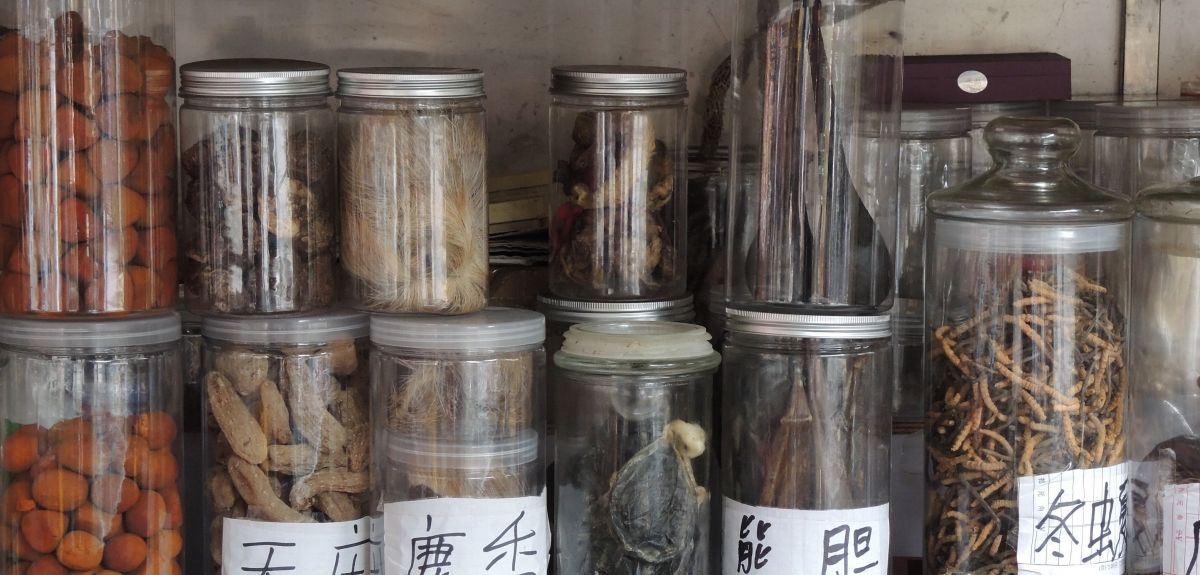
Credit: Amy Hinsley / University of Oxford
Building sustainability into traditional Chinese medicine trade on the new Silk Roads
By Amy Hinsley
Promoted as a 21st century version of the ancient Silk Roads, China’s Belt & Road Initiative (BRI) aims to improve global connectivity and change the shape of international trade. The multi-billion-dollar project will link China with countries in Southeast and Central Asia, East Africa, Europe and beyond, building a network that will include almost two thirds of the world’s population.
From a conservation and sustainability perspective, the roads, railways and ports that form the land ‘belts’ and marine ‘roads’ of the BRI have received some attention but the aim to expand Traditional Chinese Medicine to the world has not. This may be a serious oversight, as products used in TCM are derived from plant, animal and fungal ingredients, many of which are wild-sourced. This means that rapidly growing markets could put pressure on species harvested legally to supply them, and may even lead to an increase in illegal trade to supply informal markets. However, it also brings opportunities for well-managed sustainable trade, which can bring significant benefits to people in poor, rural communities with few other livelihood options.
In our new paper in Nature Sustainability, we evaluate the potential risks and opportunities of Traditional Chinese Medicine expansion via the BRI with a focus on developing strategies for well-managed, sustainable wildlife trade chains. We outline four steps to achieve this and highlight the importance of Chinese leadership in this process, which aligns with the country’s goals of a green BRI. Countries including Nepal, Portugal, Poland and Zimbabwe have shown interest in working with China on developing these medicinal markets, and this diversity of countries will mean that risks and opportunities will vary greatly. The first step is therefore to work with cross-sector stakeholders in different countries to understand how Traditional Chinese Medicine markets will grow, and how this might affect supply of products made from wild species. This evidence base should then be used to develop targeted sustainability strategies, and identify priority species for which illegal and unsustainable trade may become a threat. Finally, species that can be sustainably sourced should be identified, with a focus on species and areas that present an opportunity for both conservation and poverty alleviation.
As the BRI enters its seventh year China is reaching out to more countries to cooperate on the marketing, registration and promotion of Traditional Chinese Medicine products. There is now a critical short-term window for the identification of potential risks and opportunities, to ensure that sustainability is built into these markets from the start.
BEHIND THE RESEARCH

Whilst our conservation experience working on wildlife trade issues allowed us to consider in detail the potential risks that might arise from better connectivity and increased demand for TCM products, it was clear that to create meaningful impact we must get buy-in from relevant stakeholders. We secured an opportunistic meeting with representatives of the Chinese Association of TCM (CATCM) in Beijing, who work with the TCM industry, including on BRI expansion. Following discussions with CATCM we established that there was interest in developing more sustainable TCM supply-chains in BRI countries. However, we also established that the situation was going to be highly complex, with both supply and demand of TCM products likely to vary greatly between different countries and regions.
We invited authors from different disciplines and sectors to help develop a strategy for sustainability that could account for the complexity of BRI TCM markets. Our final author team includes academics and practitioners working on wildlife trade, livelihoods, and sustainable supply-chains for medicinal plants, as well as a policy-maker in China with experience of working on TCM and conservation. This collaboration resulted in a paper that lays out a realistic, four-step strategy for understanding the risks of BRI TCM and turning them into opportunities for sustainability. As the BRI enters its seventh year China is reaching out to more countries to cooperate on the marketing, registration and promotion of TCM products. There is now a critical short-term window for the identification of potential risks and opportunities, to ensure that sustainability is built into these markets from the start.
The paper is available in both English and Chinese language versions.